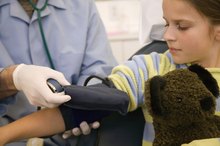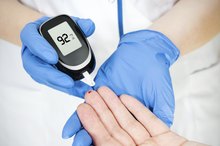Diabetes & Hot Flashes After Eating Breakfast
Diabetes causes changes in blood sugar levels that can occur suddenly, especially after eating. While most diabetics focus on how high their blood sugars rise after eating, a sudden drop in blood sugar, called hypoglycemia, can also cause serious problems. Since neither diabetes nor high blood sugar levels cause hot flashes, a possible cause of what appear to be hot flashes after eating may be hypoglycemia.
Causes
Diabetics may experience hypoglycemia after eating for a number of reasons. If you take more insulin than needed for the amount of food eaten, your blood sugars can drop too low, because insulin helps glucose enter cells and tissues. Too much insulin removes too much glucose from your blood. Not eating at all after taking insulin or exercising strenuously, which burns up more calories and glucose than usual, can also cause hypoglycemia. Even if you don’t take insulin, your body may release a large amount of insulin in response to a meal high in carbohydrates. Oral hypoglycemics used to treat diabetes can also cause hypoglycemia.
- Diabetics may experience hypoglycemia after eating for a number of reasons.
- Not eating at all after taking insulin or exercising strenuously, which burns up more calories and glucose than usual, can also cause hypoglycemia.
Symptoms
What Are Glucose Tablets Used For?
Learn More
Hypoglycemia causes flushing, sweating, fast heartbeat, shakiness, confusion and weakness, similar symptoms to hot flashes.cause:
- Hypoglycemia causes flushing
- sweating
- fast heartbeat
- shakiness
- confusion
- weakness
- similar symptoms to hot flashes
If you don’t treat hypoglycemia, you can lose consciousness, go into a coma and in rare cases die or have permanent brain damage.
Blood Glucose Levels
People without diabetes don’t experience flushing, shakiness and rapid heartbeat until their blood glucose levels fall below 60 mg/dL, The Merck Manual Online Medical Library states 2. Diabetics may experience symptoms at higher levels, closer to 100 mg/dL, David McCulloch, M.D., of the University of Washington reports on UpToDate. In addition, long-standing diabetics may have hypoglycemia unawareness, the inability to recognize early symptoms of hypoglycemia and respond to them before passing out. Diabetics who drink alcohol, those who keep their blood sugars under tight control, the elderly and people who take certain diabetic medications may be more likely to develop hypoglycemia unawareness.
- People without diabetes don’t experience flushing, shakiness and rapid heartbeat until their blood glucose levels fall below 60 mg/dL, The Merck Manual Online Medical Library states 2.
- In addition, long-standing diabetics may have hypoglycemia unawareness, the inability to recognize early symptoms of hypoglycemia and respond to them before passing out.
Treatment
What Are the Blood Sugar Levels for Diabetes?
Learn More
Eating a glucose tablet, having a piece of hard candy or drinking a sugary drink all help raise your blood sugar enough to relieve your symptoms. Check your blood sugar to make sure it’s rising; if it isn’t, eat something else. Don’t drive or try and carry out any activities until your blood sugar is back in your normal range.
Prevention
Related Articles
References
- The Merck Manuals Online Medical Library: Hypoglycemia
- UpToDate: Patient Information: Hypoglycemia (Low Blood Sugar) in Diabetes Mellitus
- Endocrineweb: Treatment of Diabetes
- Service FJ, Cryer PE, Vella A. Hypoglycemia in adults: Clinical manifestations, definition, and causes. UpToDate. Updated March 14, 2017.
- American Diabetes Association. 6. Glycemic Targets: Standards of Medical Care in Diabetes-2020. Diabetes Care. 2020;43(Suppl 1):S66-S76. doi:10.2337/dc20-S006
- Kishnani PS, Austin SL, Abdenur JE, et al. Diagnosis and management of glycogen storage disease type I: a practice guideline of the American College of Medical Genetics and Genomics. Genet Med. 2014;16(11):e1. doi:10.1038/gim.2014.128
- Desimone ME, Weinstock RS. Non-Diabetic hypoglycemia. In: Feingold KR, Anawalt B, Boyce A, et al., editors. Endotext. Updated September 23, 2017.
- Kalra S, Mukherjee JJ, Venkataraman S, et al. Hypoglycemia: The neglected complication. Indian J Endocrinol Metab. 2013;17(5):819-34. doi:10.4103/2230-8210.117219
- Martín-Timón I, del Cañizo-Gómez FJ. Mechanisms of hypoglycemia Unawareness and implications in diabetic patients. World Journal of Diabetes. 2015;6(7):912-926. doi:10.4239/wjd.v6.i7.912.
- Mayo Clinic. Hypoglycemia. Mayo Clinic Staff. Updated February 16, 2018.
- Service FJ, Cryer PE, Vella A. Hypoglycemia in adults: Clinical manifestations, definition, and causes. Updated March 14, 2017.
- Hormone Health Network. Nondiabetic Hypoglycemia. Endocrine Society. Updated October 2017.
Writer Bio
A registered nurse with more than 25 years of experience in oncology, labor/delivery, neonatal intensive care, infertility and ophthalmology, Sharon Perkins has also coauthored and edited numerous health books for the Wiley "Dummies" series. Perkins also has extensive experience working in home health with medically fragile pediatric patients.









